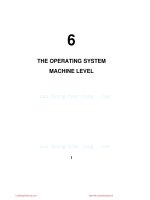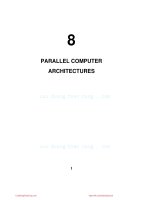kiến trúc máy tính nguyễn thanh sơn ch7 multicores, multiprocessorssinhvienzone com
Bạn đang xem bản rút gọn của tài liệu. Xem và tải ngay bản đầy đủ của tài liệu tại đây (2.02 MB, 51 trang )
Computer Architecture
Computer Science & Engineering
Chapter 7
Multicores, Multiprocessors
and Clusters
BK
TP.HCM
CuuDuongThanCong.com
/>
Introduction
Goal: connecting multiple computers
to get higher performance
Job-level (process-level) parallelism
BK
High throughput for independent jobs
Parallel processing program
Multiprocessors
Scalability, availability, power efficiency
Single program run on multiple processors
Multicore microprocessors
Chips with multiple processors (cores)
TP.HCM
22-Sep-13
CuuDuongThanCong.com
Faculty of Computer Science & Engineering
/>
2
Hardware and Software
Hardware
Software
Serial: e.g., Pentium 4
Parallel: e.g., quad-core Xeon e5345
Sequential: e.g., matrix multiplication
Concurrent: e.g., operating system
Sequential/concurrent software can run
on serial/parallel hardware
Challenge: making effective use of parallel
hardware
BK
TP.HCM
22-Sep-13
CuuDuongThanCong.com
Faculty of Computer Science & Engineering
/>
3
What We’ve Already Covered
§2.11: Parallelism and Instructions
§3.6: Parallelism and Computer Arithmetic
Associativity
§4.10: Parallelism and Advanced InstructionLevel Parallelism
§5.8: Parallelism and Memory Hierarchies
Synchronization
Cache Coherence
§6.9: Parallelism and I/O:
Redundant Arrays of Inexpensive Disks
BK
TP.HCM
22-Sep-13
CuuDuongThanCong.com
Faculty of Computer Science & Engineering
/>
4
Parallel Programming
Parallel software is the problem
Need to get significant performance
improvement
Difficulties
BK
Otherwise, just use a faster uniprocessor,
since it’s easier!
Partitioning
Coordination
Communications overhead
TP.HCM
22-Sep-13
CuuDuongThanCong.com
Faculty of Computer Science & Engineering
/>
5
Amdahl’s Law
Sequential part can limit speedup
Example: 100 processors, 90×
speedup?
Tnew = Tparallelizable/100 + Tsequential
BK
TP.HCM
22-Sep-13
CuuDuongThanCong.com
Faculty of Computer Science & Engineering
/>
6
Scaling Example
Workload: sum of 10 scalars, and 10 × 10
matrix sum
Single processor: Time = (10 + 100) × tadd
10 processors
Time = 10 × tadd + 100/10 × tadd = 20 × tadd
Speedup = 110/20 = 5.5 (55% of potential)
100 processors
Speed up from 10 to 100 processors
Time = 10 × tadd + 100/100 × tadd = 11 × tadd
Speedup = 110/11 = 10 (10% of potential)
Assumes load can be balanced across
processors
BK
TP.HCM
22-Sep-13
CuuDuongThanCong.com
Faculty of Computer Science & Engineering
/>
7
Scaling Example (cont)
What if matrix size is 100 × 100?
Single processor: Time = (10 + 10000) × tadd
10 processors
100 processors
Time = 10 × tadd + 10000/10 × tadd = 1010 × tadd
Speedup = 10010/1010 = 9.9 (99% of potential)
Time = 10 × tadd + 10000/100 × tadd = 110 × tadd
Speedup = 10010/110 = 91 (91% of potential)
Assuming load balanced
BK
TP.HCM
22-Sep-13
CuuDuongThanCong.com
Faculty of Computer Science & Engineering
/>
8
Strong vs Weak Scaling
Strong scaling: problem size fixed
As in example
Weak scaling: problem size proportional
to number of processors
10 processors, 10 × 10 matrix
100 processors, 32 × 32 matrix
Time = 20 × tadd
Time = 10 × tadd + 1000/100 × tadd = 20 × tadd
Constant performance in this example
BK
TP.HCM
22-Sep-13
CuuDuongThanCong.com
Faculty of Computer Science & Engineering
/>
9
Shared Memory
SMP: shared memory multiprocessor
Hardware provides single physical
address space for all processors
Synchronize shared variables using locks
Memory access time
UMA (uniform) vs. NUMA (nonuniform)
BK
TP.HCM
22-Sep-13
CuuDuongThanCong.com
Faculty of Computer Science & Engineering
/>
10
Example: Sum Reduction
Sum 100,000 numbers on 100 processor UMA
Each processor has ID: 0 ≤ Pn ≤ 99
Partition 1000 numbers per processor
Initial summation on each processor
sum[Pn] = 0;
for (i = 1000*Pn;
i < 1000*(Pn+1); i = i + 1)
sum[Pn] = sum[Pn] + A[i];
Now need to add these partial sums
Reduction: divide and conquer
Half the processors add pairs, then quarter, …
Need to synchronize between reduction steps
BK
TP.HCM
22-Sep-13
CuuDuongThanCong.com
Faculty of Computer Science & Engineering
/>
11
Example: Sum Reduction
BK
half = 100;
repeat
synch();
if (half%2 != 0 && Pn == 0)
sum[0] = sum[0] +
sum[half-1];
/* Conditional sum needed
when half is odd;
Processor0 gets missing
element */
half = half/2; /* dividing
line on who sums */
if (Pn < half) sum[Pn] =
sum[Pn] + sum[Pn+half];
until (half == 1);
TP.HCM
22-Sep-13
CuuDuongThanCong.com
Faculty of Computer Science & Engineering
/>
12
Message Passing
Each processor has private physical
address space
Hardware sends/receives messages
between processors
BK
TP.HCM
22-Sep-13
CuuDuongThanCong.com
Faculty of Computer Science & Engineering
/>
13
Loosely Coupled Clusters
Network of independent computers
Each has private memory and OS
Connected using I/O system
Suitable for applications with independent tasks
Web servers, databases, simulations, …
High availability, scalable, affordable
Problems
BK
E.g., Ethernet/switch, Internet
Administration cost (prefer virtual machines)
Low interconnect bandwidth
c.f. processor/memory bandwidth on an SMP
TP.HCM
22-Sep-13
CuuDuongThanCong.com
Faculty of Computer Science & Engineering
/>
14
Sum Reduction (Again)
Sum 100,000 on 100 processors
First distribute 100 numbers to each
Reduction
BK
The do partial sums
sum = 0;
for (i = 0; i<1000; i = i + 1)
sum = sum + AN[i];
Half the processors send, other half receive
and add
The quarter send, quarter receive and add, …
TP.HCM
22-Sep-13
CuuDuongThanCong.com
Faculty of Computer Science & Engineering
/>
15
Sum Reduction (Again)
Given send() and receive() operations
limit = 100; half = 100;/* 100 processors */
repeat
half = (half+1)/2; /* send vs. receive
dividing line */
if (Pn >= half && Pn < limit)
send(Pn - half, sum);
if (Pn < (limit/2))
sum = sum + receive();
limit = half; /* upper limit of senders */
until (half == 1); /* exit with final sum */
BK
Send/receive also provide synchronization
Assumes send/receive take similar time to addition
TP.HCM
22-Sep-13
CuuDuongThanCong.com
Faculty of Computer Science & Engineering
/>
16
Grid Computing
Separate computers interconnected by
long-haul networks
E.g., Internet connections
Work units farmed out, results sent back
Can make use of idle time on PCs
E.g., SETI@home, World Community Grid
BK
TP.HCM
22-Sep-13
CuuDuongThanCong.com
Faculty of Computer Science & Engineering
/>
17
Multithreading
Performing multiple threads of execution in
parallel
Fine-grain multithreading
Switch threads after each cycle
Interleave instruction execution
If one thread stalls, others are executed
Coarse-grain multithreading
BK
Replicate registers, PC, etc.
Fast switching between threads
Only switch on long stall (e.g., L2-cache miss)
Simplifies hardware, but doesn’t hide short stalls (eg,
data hazards)
TP.HCM
22-Sep-13
CuuDuongThanCong.com
Faculty of Computer Science & Engineering
/>
18
Simultaneous Multithreading
In multiple-issue dynamically scheduled
processor
Schedule instructions from multiple threads
Instructions from independent threads
execute when function units are available
Within threads, dependencies handled by
scheduling and register renaming
Example: Intel Pentium-4 HT
Two threads: duplicated registers, shared
function units and caches
BK
TP.HCM
22-Sep-13
CuuDuongThanCong.com
Faculty of Computer Science & Engineering
/>
19
Multithreading Example
BK
TP.HCM
22-Sep-13
CuuDuongThanCong.com
Faculty of Computer Science & Engineering
/>
20
Future of Multithreading
Will it survive? In what form?
Power considerations simplified
microarchitectures
Tolerating cache-miss latency
Simpler forms of multithreading
Thread switch may be most effective
Multiple simple cores might share
resources more effectively
BK
TP.HCM
22-Sep-13
CuuDuongThanCong.com
Faculty of Computer Science & Engineering
/>
21
Instruction and Data Streams
An alternate classification
Data Streams
Single
Instruction Single
Streams
Multiple
Multiple
SISD:
Intel Pentium 4
SIMD: SSE
instructions of x86
MISD:
No examples today
MIMD:
Intel Xeon e5345
SPMD: Single Program Multiple Data
A parallel program on a MIMD computer
Conditional code for different processors
BK
TP.HCM
22-Sep-13
CuuDuongThanCong.com
Faculty of Computer Science & Engineering
/>
22
SIMD
Operate elementwise on vectors of data
E.g., MMX and SSE instructions in x86
All processors execute the same
instruction at the same time
BK
Multiple data elements in 128-bit wide registers
Each with different data address, etc.
Simplifies synchronization
Reduced instruction control hardware
Works best for highly data-parallel
applications
TP.HCM
22-Sep-13
CuuDuongThanCong.com
Faculty of Computer Science & Engineering
/>
23
Vector Processors
Highly pipelined function units
Stream data from/to vector registers to units
Data collected from memory into registers
Results stored from registers to memory
Example: Vector extension to MIPS
32 × 64-element registers (64-bit elements)
Vector instructions
lv, sv: load/store vector
addv.d: add vectors of double
addvs.d: add scalar to each element of vector of double
Significantly reduces instruction-fetch bandwidth
BK
TP.HCM
22-Sep-13
CuuDuongThanCong.com
Faculty of Computer Science & Engineering
/>
24
Example: DAXPY (Y = a × X + Y)
Conventional MIPS code
l.d
$f0,a($sp)
addiu r4,$s0,#512
loop: l.d
$f2,0($s0)
mul.d $f2,$f2,$f0
l.d
$f4,0($s1)
add.d $f4,$f4,$f2
s.d
$f4,0($s1)
addiu $s0,$s0,#8
addiu $s1,$s1,#8
subu $t0,r4,$s0
bne
$t0,$zero,loop
Vector MIPS code
l.d
$f0,a($sp)
lv
$v1,0($s0)
mulvs.d $v2,$v1,$f0
lv
$v3,0($s1)
addv.d $v4,$v2,$v3
sv
$v4,0($s1)
;load scalar a
;upper bound of what to load
;load x(i)
;a × x(i)
;load y(i)
;a × x(i) + y(i)
;store into y(i)
;increment index to x
;increment index to y
;compute bound
;check if done
;load scalar a
;load vector x
;vector-scalar multiply
;load vector y
;add y to product
;store the result
BK
TP.HCM
22-Sep-13
CuuDuongThanCong.com
Faculty of Computer Science & Engineering
/>
25









